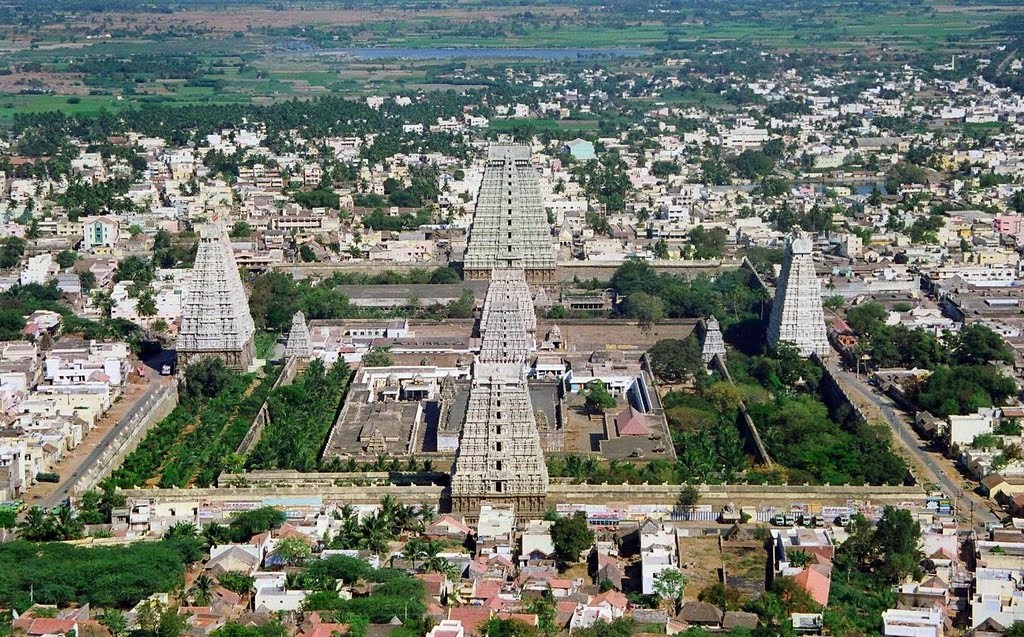This is the Fourth in the five part Shiva series of articles that will be published in this week of Sravana Month.
Annamalaiyar Temple is dedicated to Lord Shiva and is located at the base of the Annamalai Hills in the town of Thiruvannamalai in Tamil Nadu. Here Shiva is here worshiped as Arunachaleswara. The temple is one of the Pancha Bhoota Stalas and represents the Agni (Fire) element. The lingam here is Agni lingam and his consort Parvathi is known as Unnamulai Amman.
Arunachaleswara is in an ancient town dotted with numerous temples along the Girivalam, a 14km pathway that devotees use to circumnavigate the Annamalai hills before entering the town’s main temple. It is believed that the Tiruvannamalai hills are rich in herbs, it has the reputation of being as one of the best centre for Sidda Medicine and Yoga. Every full-moon night, lakhs of devotees arrive here for the holy Girivalam (perambulation).

History
The temple complex is spread across 10 hectares and is one of the largest temples in India. The temple has four gateway towers known as gopurams and the tallest is the eastern tower with 11 stories and a height of 217 ft, which also makes it one of the tallest temple towers in the country. The temple complex houses numerous shrines apart from the shrines of Shiva and Parvathi and also has many halls. The most notable is the thousand-pillared hall built during the Vijayanagar period. The present stone works and towers date back to the 9th century by the Chola Kings. Prior to the Chola’s Thiruvannamalai was under the Pallava Kings who ruled from Kanchipuram.
Must Read Shiva Temples : Jambukeswara Temple – Purity of Devotion
Legend
According to the Mythology, Once Vishnu and Brahma were contesting against each other for superiority and to divert them Shiva appeared before them as a flame and urged them to find the source. It was decided that whoever returned first after seeing the head and the foot of the luminous pillar would be adjudged as the greater. Brahma in the form of a swan flew up in quest of the top while Vishnu took the form of a boar and dug deep into the earth to find out the bottom. Vishnu’s efforts were of no avail and he returned without success. Brahma was about to return when he saw a Thalambu (a fragrant flower also known as Kethaki) coming down. He requested the flower to say that both of them came down after seeing the top. Meeting Vishnu, Brahma said that he was the winner and cited Thalambu as the witness. It was then that Shiva appeared before them and said that the flower and Brahma had told a lie. He then adjudged Vishnu as the superior of the two. Shiva, as the blazing mountain became a hill and a Lingam appeared at the foot of the hill. Thus the Agni Linga came to exist on the hill of Thiruvannamallai and Arunachalaeshwar.
Legend of Ardhanareswara
Once Parvathi was separated from Shiva and as she was in Kancheepuram doing Penance blessed, impressed with her Shiva guides her to Tiruvannamalai.
Parvati at Tiruvannamalai worshipped Shiva to get her rightful place in the left half of his body (Vamabhaga). There she was instructed by Maharishi Gouthama to worship Shiva by going round Arunachala Chanting Shiva’s name. In the course of her penance Parvati encountered Mahisha Soora,who she kills in the fight. After killing Mahishasoora Shiva advises her to take bathe theertham (Tank) for getting rid of the Siva Linga, which adhered to her hand. After Bathing PArvathi hears Shiva’s voice urging her to be “United with Him”. Parvati arranges for a Deva Yagna, commencing from Uttara Nakshatra and concluding on the Karthika day. On the Karthigai day just as Parvathi completes her pradakshina around the hill, Shiva appears as a blazing light on the hill blessed her by absorbed her in the left half of his body. Thus came the form of Ardhanareshwar. To denote this occurrence the Ardhanareshwar deity is brought out at the time of Karthigai Deepam festival

Architechture
There are Four Gopurams in four directions and a Thousand-Pillared Hall at the bottom of the Annamalai Hills and the Main Temple faces east. The eastern tower or the Rajagopuram is the tallest amongst the four. The construction of this tower was started by Krishnadevaraya of the Vijayanagara empire and was completed by Sevappa Nayaka. The south tower is called Thirumanjangopuram, the west tower is known as Pei Gopuram and the north tower is named after Ammani Ammal, a sanyasini who built it. Each Gopuram’s hold a huge Nandi( the vehicle of Shiva). The other towers here are Kili Gopuram or parrot tower and the Vallala Maharaja Gopuram. To reach the innermost sanctum one must pass through five prakarams or compounds.

One can find a sixteen-pillared Deepa Darshana Mandapam (hall of light) at the third precinct. In the fourth precinct one can find a six-foot-tall Nandi which was erected by Vallala Maharaja. A thousand-pillared hall built during the late Vijayanagara period by Krishnadevaraya along with the temple tank can be found in the fifth precinct. The pillars in the hall are carved with images of Yali, a mythological beast with the body of a lion and the head of an elephant.
Beliefs
Devotees believe that the walk around the Girivalam removes the sins and fulfills their desires and helps one to find Moksha, freedom from the cycle of birth and rebirth.

Festivals
Karthika Masam and Shivarathri are the most popular festivals here.
But every month on Paurnami day thousands of Devotees Throng the hills and worship the Arunachaleswara.
Must Read Shiva Temples : Ekambareswar , The Lord of Mango Tree









